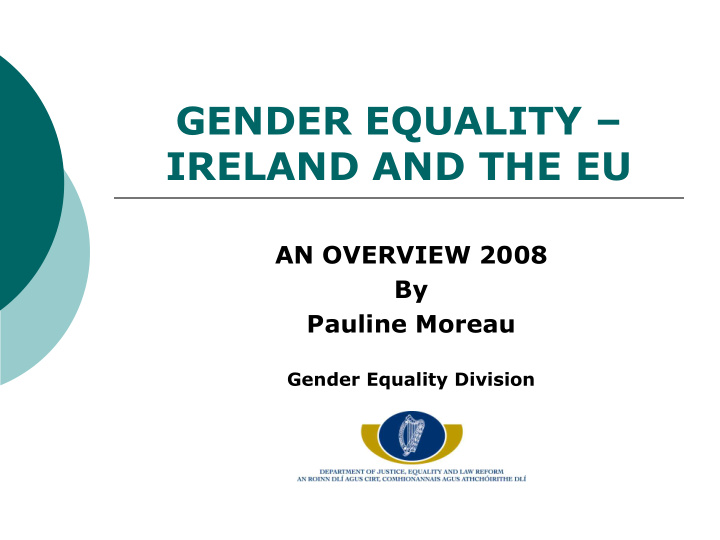



GENDER EQUALITY – IRELAND AND THE EU AN OVERVIEW 2008 By Pauline Moreau Gender Equality Division
TOPICS TODAY A Quiz A little history Gender Equality and the EU Gender Equality in Ireland
THE QUIZ Thirty years after the equality legislation was put in place, why are we still addressing Gender Equality in Ireland? Roughly half our citizens are women, so what percentage of politicians in the Dáil/Seanad are women?
THE QUIZ Women make up about 45 per cent of our work force, so what percentage of major private enterprises (Ireland’s Top 500) are headed by a woman? Women make up 67 per cent of all general service grades in the Civil Service, so what is the percentage of women in the A/Sec to Sec Gen grades taken together?
A LITTLE HISTORY 1971 : Commission on the Status of Women favoured, among other issues Equal pay Women to have choice to remain in work after marriage 1973 : Ireland joined the EEC Equality between women and men enshrined in the Treaty of Rome Ireland required to transpose EEC Equality Legislation including, over time Right to remain in the work place upon marriage Equal pay Maternity leave Maternity protection
A LITTLE HISTORY Ireland’s socio -economic structures changed significantly – more women at work, population better educated, modern economy emerged… In 1991, the Second Commission on the Status of Women recommended National minimum wage Need for childcare policy Women’s increased participation in public life
EUROPEAN UNION AND GENDER Mid – term of 1994 -1999 Structural Funds Programme - Commission recommended increased investment in Childcare in Ireland to support women at work Lisbon Strategy 2000 : Create the most competitive and dynamic knowledge based economy capable of sustaining economic growth with more and better jobs and greater social cohesion Increase female labour market participation for economic growth and to support aging population – pensions Invest in people and build an active welfare state
EUROPEAN UNION AND GENDER 2006 Spring European Council Acknowledged that gender equality policies are vital to economic growth, prosperity and competitiveness … It is time to make a firm commitment at European level to implement policies to promote women’s employment and to ensure a better work life balance Approved the European Gender Pact.
EUROPEAN GENDER PACT Encourage actions by MS and at Union level under the headings: Measures to close gender gaps and combat gender stereotypes in the labour market Measures to promote a better work life balance for all Measures to reinforce governance through gender mainstreaming and better monitoring
EUROPEAN GENDER PACT New EU policy documents and draft regulations in relation to Enhanced maternity protection (Ireland already in a better situation) Better leave entitlements – parental leave; shared leave; etc (Economic issues for Ireland if these were to be paid leaves; issues for private sector) Enhanced initiatives on gender mainstreaming and gender budgeting Disaggregated statistics is a first step
NATIONAL POLICY ON GENDER Implementation of Legislation – Equality Authority and Tribunal National Women’s Strategy 2007 – 2016 Programme of Positive Actions – Equality for Women Measure Gender Mainstreaming International Commitments
NATIONAL WOMEN’S STRATEGY 2007 - 2016 A ten year “All of Government” Strategy Launched by the Taoiseach in April 2007 Funding of € 58 million promised under NDP 20 Key objectives and more than 200 actions to achieve An Ireland where all women enjoy equality with men and can achieve their full potential while enjoying a safe and fulfilling life
NATIONAL WOMEN’S STRATEGY KEY THEMES – THE THREE “E”s Equalising Socio Economic Opportunity For Women WOMEN IN IRELAND Engaging Ensuring Women as Women’s Equal and Well being Active Citizens
NWS - THEME 1 EQUALISING SOCIO-ECONOMIC OPPORTUNITY (1) Work Increasing nos. of women at work Tackling the gender pay gap Advancing women’s careers Education and women Subject choices
NWS - THEME 1 (Contd.) EQUALISING SOCIO-ECONOMIC OPPORTUNITY (2) Women and caring Childcare/ disabled care/elder care Women and poverty Family wellbeing Lone parents Older age Women’s pensions
NWS - THEME 2 ENSURING WOMEN’S WELLBEING Work life balance Leave entitlements Sharing caring responsibilities Long hours culture Health/healthy lifestyles/sport Health and safety particularly for pregnant and breast feeding women Bullying and harassment Violence against Women/ Trafficking
NWS - THEME 3 ENGAGING WOMEN AS EQUAL AND ACTIVE CITIZENS Women in decision making State Boards On boards of private companies Politics Women in the Arts and Media Gender Stereotypes Women in developing countries
EQUALITY FOR WOMEN MEASURE 2008 – 2013 Positive action programme to support women New phase building on past experience when in 2000 – 2007 period there were 30,000 beneficiaries € 62 million pledged in NDP, including € 15.75 million ESF under HCIOP
EQUALITY FOR WOMEN MEASURE 2008 – 2013 New EWM likely to have four distinct strands o Returning to or preparing for work o Training for advancement in employment o Women and entrepreneurship o Women and decision-making
CHALLENGES AHEAD Oversee implementation of National Women’s Strategy Implement Equality for Women Measure as funding permits Encourage greater gender mainstreaming Work with implementers of National Development Plan and NSRF and broader Civil Service to ensure gender is appropriately covered in these bodies of work and other national policy documents Continue to engage at EU and other multi- lateral levels
And the answers to the quiz are… Thank you - PAULINE MOREAU - pmmoreau@justice.ie
THE QUIZ Thirty years after the equality legislation was put in place, why are we still addressing Gender Equality in Ireland? Roughly half our citizens are women, so what percentage of politicians in the Dáil/Seanad are women? 13 pe cent
THE QUIZ Women make up about 45 per cent of our work force, so what percentage of major private enterprises (Ireland’s Top 500) are headed by a woman? 5 per cent Women make up 67 per cent of all general service grades in the Civil Service, so what is the percentage of women in the A/Sec to Sec Gen grades taken together? 12 per cent
Recommend
More recommend